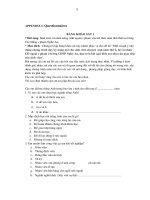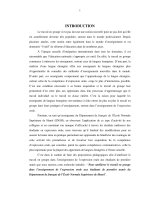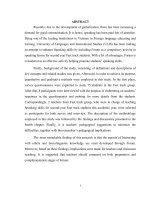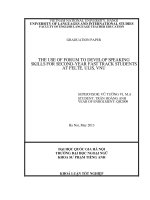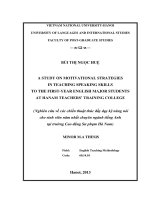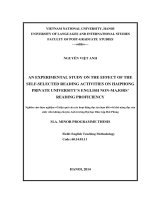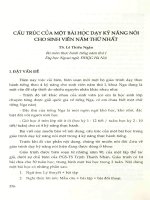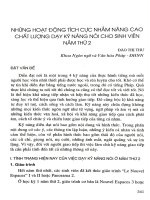Phát huy tính tự chủ đối với kỹ năng nói cho sinh viên chuyên ngành tiếng Anh năm thứ nhất tại trường Đại học Thương mại
Bạn đang xem bản rút gọn của tài liệu. Xem và tải ngay bản đầy đủ của tài liệu tại đây (1.57 MB, 70 trang )
VIETNAM NATIONAL UNIVERSITY, HA NOI
UNIVERSITY OF LANGUAGES AND INTERNATIONAL STUDIES
FACULTY OF POSTGRADUATE STUDIES
***
PHẠM THỊ PHƯỢNG
DEVELOPING LEARNER AUTONOMY IN LEARNING
SPEAKING SKILL FOR THE FIRST YEAR ENGLISH-
MAJOR STUDENTS AT THE UNIVERSITY OF
COMMERCE: AN ACTION RESEARCH
(Phát huy tính tự chủ đối với kỹ năng nói cho sinh viên chuyên ngữ năm
thứ nhất tại trường Đại học Thương mại: Nghiên cứu áp dụng)
M.A. MINOR THESIS
Field : English Methodology
Code : 60 14 10
Hanoi, 2010
VIETNAM NATIONAL UNIVERSITY, HA NOI
UNIVERSITY OF LANGUAGES AND INTERNATIONAL STUDIES
FACULTY OF POSTGRADUATE STUDIES
***
PHẠM THỊ PHƯỢNG
DEVELOPING LEARNER AUTONOMY IN LEARNING
SPEAKING SKILL FOR THE FIRST YEAR ENGLISH-
MAJOR STUDENTS AT THE UNIVERSITY OF
COMMERCE: AN ACTION RESEARCH
(Phát huy tính tự chủ đối với kỹ năng nói cho sinh viên chuyên ngành
tiếng Anh năm thứ nhất tại trường Đại học Thương mại:
Nghiên cứu áp dụng)
M.A. MINOR THESIS
Field : English Methodology
Code : 60 14 10
Supervisor : Đỗ Bá Qu ý, M.Ed.
Hanoi, 2010
iv
TABLE OF CONTENTS
DECLARATION i
ACKNOWLEDGEMENTS ii
ABSTRACT iii
LIST OF TABLES AND FIGURES vi
PART A: INTRODUCTION 1
1. Rationale for the study 1
2. Aims of the study 2
4. Scope of the study 3
5. Structure of the study 3
PART B. DEVELOPMENT 4
CHAPTER 1: LITERATURE REVIEW 4
1.1. Learner autonomy 4
1.1.1. Definition of autonomy 4
1.1.2. Roles of autonomy 5
1.1.3. Characteristics of learner autonomy 7
1.1.4. Teacher‟s roles in learner autonomy 9
1.1.5. Ways to develop autonomy 10
1.2. Speaking skill 13
1.2.1. The nature of speaking and characteristics of an effective speaking lesson 13
1.2.2. Autonomy in speaking skill 14
CHAPTER 2. AN OVERVIEW OF TEACHING AND LEARNING SITUATION
AT ENGLISH DEPARTMENT, UNIVERSITY OF COMMERCE (VUC) 17
2.1. English department at VUC 17
2.2. The teaching syllabus for speaking skill 17
2.3. The opportunities and constraints of the context 19
2.3.1. The opportunities of the context 19
2.3.2. The constraints of the context 19
CHAPTER 3: METHODOLOGY 20
3.1. Research question 20
v
3.2. Subjects of the study 20
3.3. Research design 20
3.3.1. Description of data collection instruments 23
3.3.2. Detailed description of module 1 24
3.3.3. Detailed description of module 2 25
CHAPTER 4: DATA ANALYSIS AND FINDINGS 27
4.1. Students‟ performance and attitudes towards the project 27
4.2. Student‟s speaking proficiency 31
4.3. Students‟ attitudes towards learning process 33
PART C. CONCLUSION 36
1. Conclusions 36
2. Recommendations 36
3. Limitations 38
4. Suggestions for further study 38
REFERENCES 39
APPENDIX 1 I
APPENDIX 2 V
APPENDIX 3 VI
APPENDIX 4 VII
APPENDIX 5 X
APPENDIX 6 XIII
APPENDIX 7 XVI
APPENDIX 8 XVII
APPENDIX 9 XVIII
vi
LIST OF TABLES AND FIGURES
Table 1: Characteristics of independent learning 8
Table 2: Students‟ attitudes and performance during the project 27
Table 3: The benefits of the projects to the students 29
Table 4: Students‟ self-evaluation of their speaking skill 32
Figure 1: The Learner Independence Continuum 8
Figure 2: Students‟ opinions on the continuity of a similar project 30
Figure 3: Level of students‟ involvement during the project 31
Figure 4: Students‟ changes in their perception of learner autonomy 34
1
PART A: INTRODUCTION
1. Rationale for the study
Over the last three decades, learner autonomy in language learning has been a “buzz-word” in
the field of second language education. In fact, few teachers will disagree with the importance
of helping language learners become more self-directed. It is so robust that there are
numerous books and articles (Holec, 1981; Dickinson 1987; Riley 1988; Little, 1991; Little,
1999; Littlewood, 1999; Tudor, 1996, etc.) and the proliferation of researches on the theme
(Kavaliauskiene, 2003; Ali, 2000; Coombe, 2001; Barrett & Daborn, 2001; Malcolm, 2001;
Luchini & Rosello, 2007, etc.).
Despite the concerted effort made to implant learner autonomy, it is still at a low level in the
university setting in Vietnam. The students in University of Commerce are of no exception.
Even the students who major in English exhibit low responsibility in their English - learning
process. The students are lukewarm and lack of determination and self-discipline to learn
independently. Observations in the classrooms reveal the lack of the cooperative learning. The
general atmosphere in the class seems to be very formal. Students only raise their voices once
they are called upon. When asked to work in pairs and groups in speaking lessons, they start
to write down their own ideas as a long presentation or some key points and revise their own
work individually, and ready to communicate only when they are perfectly sure of their part
and their ideas. Furthermore, they are generally reluctant to question the teacher or give their
opinions.
An open discussion in Vietnamese with the students explicates that their low autonomy has
resulted from psychological, social and personal grounds. Their misleading beliefs, minute
confidence, restricted knowledge as well as the previous learning experience are agreed upon
as the primary causes of their passive learning style. The beliefs and attitudes learners hold
have a profound influence on their learning behaviors. It is, therefore, essential to assist
students in moving towards greater autonomy, especially in learning speaking. Teachers
should validate the importance of autonomy to the students as an ancient proverb going “Give
a man a fish, feed him for a day. Teach a man to fish, feed him for a lifetime.”
This situation compels the conduction of this research to aid students in their second language
learning and life-long learning. This is genuinely no easy task since autonomy does not
flourish automatically. Due to the highly complex nature of language and language learning,
2
augmenting autonomy in language learners often proves to be a doubly difficult objective.
Although few researches have been done in Vietnam to boost student‟s active engagement in
speaking, a large number of studies in other countries have reported favorable results in
developing their students‟ autonomy. Experimental practice has been exploited to empower
teachers by bringing a research perspective into their classrooms, where ordinary classroom
activities are modified for their investigative potential. Most of them use awareness-raising
activities, portfolio, self-assessment, homework and assignment in their studies. Inaugurated
from these practices, the present paper is an attempt to search the current researches then
devise a pertinent project of actions for the students in English Department, University of
Commerce (VUC), who have mediocre level of learning autonomy. The expectation is to help
learners generate a sense of autonomy in language learning, elevate the students‟ speaking
skill as well as render effective speaking lessons.
2. Aims of the study
This research aims at
- identifying the current VUC English – major freshmen‟s autonomy in speaking skill
- working out the appropriate scheme of actions to improve the situation
- finding out the effectiveness of the selected activities in the action plan
- reflecting the results of the study
From the outcomes, some implications will be suggested for handling and applying classroom
activities to promote the students‟ autonomy in learning speaking.
In particular, it is conducted to ascertain the answer to the following question:
Can raising students' awareness of the importance of learner autonomy and application of
selected activities help improve autonomy in learning speaking skill for first year English-
major students at the University of Commerce ?
3. Methods of study
As mentioned above, this is an action research to solve the problem of low level of learner
autonomy at English Department, VUC. To reach the goal, a project is launched into the
classroom environment. It is divided into two modules, the former consists of selected
awareness-raising activities, learner contract signing, and essential speaking-strategies
training activities to raise students‟ awareness of the problem as well as equip them with
necessary skills to acquire more confidence in speaking skill. The latter pertains to the
3
practice of such skills in doing their home assignments and in-class activities to habituate
their speaking practice and active engagement. Besides, public appearance is deferred to the
final stage, when students have become more experienced. Specifically, students practice
working in pairs before having public speaking to amplify their self-reliance progressively.
After the action, questionnaires, interviews and classroom observations are conducted to get
the feedback. The data aims at getting the students evaluation on the activities and more
remarkably, to examine whether they become more autonomous.
4. Scope of the study
Learner autonomy is undoubted to be the vast issue in the second language learning. It
encompasses different aspects and areas. Therefore, this study touches upon only one
researchable aspect of autonomy, i.e., developing autonomy in speaking skill. In the literature,
there is a range of actions to ensure students self-directed learning; however, several pertinent
activities are adopted in consideration of the context of University of Commerce and the small
scale of this research for the sake of limited time and students‟ low level. Furthermore, the
subjects of this study are the first year students who major in English as these freshmen often
exhibit the least autonomy in learning and implore a good start for their students‟ life.
5. Structure of the study
This paper is organized into three main parts as follows:
Part A: Introduction
This part presents the rationale, the aim, scope, method and design of the study.
Part B: Development
This part is divided into different chapters. Chapter 1 serves as the theoretical background for
the study, presenting the concepts and relevant theories. Chapter 2 gives an overview of
teaching and learning situation at English Department, VUC. Chapter 3 deals with the actual
procedures of the study: methodology, subjects and data collection procedures. Chapter 4
presents the finding and analysis of the data collected.
Part C: Conclusion
This last part of the study recaps the main content of the study and deals with some
suggestions for improving student‟s autonomy in studying speaking skill. In addition, it also
poses several directions for future research.
4
PART B. DEVELOPMENT
CHAPTER 1: LITERATURE REVIEW
This chapter serves as the theoretical background for the study. The definitions and roles of
autonomy and speaking skill were given to clarify the subject matters investigated and the
significance of the matters. Moreover, the characteristics of autonomy, roles of teachers and
ways to develop learner autonomy receive more details and attention as to find out an efficient
learner autonomy enhancing process.
1.1. Learner autonomy
1.1.1. Definition of autonomy
Nowadays, the language teaching has become more and more communication-oriented,
pushing the traditional classroom teaching to a situation of big challenge. The learner-
centered ones are replacing the traditional classrooms where teachers play the role of
knowledge transmission. This learner-centered approach in EFL has brought out the notion of
leaner autonomy in learning EFL.
Among the scholars in this field, Holec, one of the earliest advocates of autonomy in language
teaching Holec began by defining learner autonomy as the “ability to take charge of one‟s
own learning” (1981, p. 3). He endorses that this ability “is not inborn but must be acquired
either by “natural” means or by formal learning, i.e. in a systematic, deliberate way”, and
stresses the idea of man as “producer of his society” but not “product of his society” (Holec
1981, p.1). His definition remains the basis for many researchers. Nevertheless, there is no
consensus as to what the term “autonomy” really is. For Little (1999), autonomy is “a
capacity for a certain range of highly explicit behavior that embraces both the process and the
content of learning” (p. 11). Littlewood (1999, p. 73) regards autonomy in educational terms
as “involving students‟ capacity to use their learning independently of teachers.” Scharle and
Szabo (2000, p. 4) holds that autonomy means “the freedom and ability to manage one‟s own
affairs, which entails the right to make decisions as well.”
Although definitions of learner autonomy have varied, they all agree that students should take
responsibility for their own learning. Taking responsibility involves learners in taking
ownership (partial or total) of processes which have traditionally belonged to the teacher, such
as deciding on learning objectives, selecting learning methods and assessing progress.
5
Since it is acknowledged that none of us can escape entirely from the cultural assumptions
and practices that have shaped us, the concept of learner autonomy has shifted from individual
to situational view. As Riley (1988, p. 17) and Tudor (1996, pp. 141-142) suggest, the ideas
and practice of autonomy and learner-centeredness are ethnocentric. Little (1999) remarks
that “we must always pay careful attention to the cultural setting in which learning takes
place” as “all learning is socially situated and culturally constrained” (pp. 15-16). In other
words, the concept of autonomy certainly incorporates aspects of learners' national or regional
cultures. Thus, we should match aspects of autonomy with the characteristics and needs of our
learners in relation to our specific contexts
Although autonomy has been interpreted differently, it is essential to point out what autonomy
is not. Little (1991, p.3) indicates five misconceptions about autonomy: 1) autonomy is
synonymous with self-instruction, 2) autonomous learners make the teacher redundant, 3)
autonomy is a new methodology, 4) autonomy is a single easily described behavior, and 5)
autonomy is a steady state achieved by certain learners. What needs to be highlighted is that
autonomy is a universal human capacity that cannot be nurtured overnight. Teachers should
create an autonomous leaning environment in relation to a specific context to cultivate a kind
of learner who can continue their life-long learning independently.
1.1.2. Roles of autonomy
Developing learner autonomy has sound theoretical, practical and experiential grounds. It is
rooted on the theory of constructivism and learner-centered, which are reckoned as the current
profitable trends in second language learning and a great number of proven researches in the
field.
Constructivists assert that different men construe the universe in different way and their
perception of the world can only achieved by means of successive own discoveries and
investigations (Kelly, 1963). Consequently, to learn a second language successfully, students
must “take proactive roles to build up and construct the knowledge” (Candy, 1991, p.270)
rather than being taught by others.
In addition, autonomy is closely related with and deemed to be borne out of learner-centered
approach. The learner-centered theory posits that learners must be the focus and the initiators
as well as the responsible actor assuring the success of learning a language but not the
teachers. It embraces improving the student‟s awareness of himself or herself as a learner, the
6
process of language learning and use, the nature of the target language and language use
strategies (Dickinson, 1987; Holec, 1981; Wenden & Rubin, 1987). Hence, this novel
approach underpins the individualization of instruction, the focus on the process of learning,
not on the product itself.
In reality, there is an overriding need to take more responsibilities in studying a foreign
language. The current syllabus and program evince the reduction in classroom time and the
current Vietnamese context cannot offer many opportunities to use a language outside class. It
is misleading to assume that reducing the number of class meetings means reducing students‟
workload. Instead, the shift to credit program in university curricula necessitates more
students‟ control and responsibility over their own learning. They must continue learning on
their own after leaving the language course. This self-study evidently helps enrich the input
and skills (Deci, 1995).
The situation current reinforces the need to cultivate and foster learner autonomy. Evidently,
there are a great number of researches in the field which have proved the values of learner
autonomy development, showing the intertwined relationship between autonomy and
motivation. When learners are proactively committed to their learning, the problem of
motivation is testified to be solved. In Deci‟s words, “autonomy is nourished by, but in turn
nourishes our intrinsic motivation, our proactive interest in the world around us” (1995, p. 2).
This relationship works in both directions with different phases in a learner‟s learning
progress. Although we cannot assume that the relationship between autonomy and motivation
is always one in which autonomy leads to motivation, we can conclude undoubtedly that
developing autonomy helps students get better results (Deci, 1995).
Learner autonomy can be regarded as an offspring of learner-centered approach, which is an
innovative and effective one in the literature of second language learning. The benefits of
cultivating autonomy in learners have been disclosed by a variety of researchers and
practitioners. Learner autonomy can lead to increase in motivation and cooperation as well as
responsibilities in their studying process, which means more effective learning. Furthermore,
the concept of autonomy is not restricted in school aspect. Once students acquire autonomy in
learning in the school curriculum, they slip easily into autonomy for other activities outside
class. In other words, autonomous learners evolve life-long learning and hereby they are
capable of authoring the world in which they live.
7
1.1.3. Characteristics of learner autonomy
As regards characteristics of learner autonomy, scholars all centre on the hypothesis that
learner autonomy entails reflective involvement in planning, implementing, monitoring and
evaluating learning. However, different scholars may contribute additional attributes of
learner autonomy to these core features.
Scharle and Szabo (2000) proclaim that an autonomous student must have built four blocks,
i.e., 1) motivation and self-confidence, 2) monitoring and evaluation, 3) learning strategies,
and 4) cooperation and group cohesion. While motivation and self-confidence refer to the
intrinsic motivation and willingness to take responsibility in learning, cooperation and group
cohesion indicates that learners should liaise with each other in the learning process. The
second and third factors cover the same notion as the core features. Monitoring skills
emphasize the need to focus on the process of learning rather than the product. This step is
followed by self-evaluation, which means learners judge their own works as objectively as
they can, acknowledging their level of proficiency, their strong and weak points.
In the same line, Deci (1995) has defended three “pedagogical principles” of autonomy. The
concept of “learner involvement” in his work equates with motivation and self-confidence
proposed by Scharle and Szabo (2000); and his definition of “learner reflection” associates
with learners‟ monitoring and self-evaluation. He further adds “appropriate langue use”
implying that autonomy in language learning and autonomy in language use are two side of
the same coin (communicative dimension). Consequently, in formal language learning, the
scope of learner autonomy is always constrained by what the learner can do in the target
language. In other words, language learning depends principally on language use. For instance,
we can learn to speak only by speaking.
The above-mentioned attributes of learner autonomy are, however, too broad and need to be
further broken down into specific possible features for the sake of researching. Table 1 below
shows the characteristics of dependent learners and independent learners compiled from a
number of sources (Omaggio, 1978, cited in Wenden, 1998, pp. 41-42; Holec, 1981;
Dickinson, 1987; Little, 1991; Broady & Kenning, 1996; Barnett, 1993).
DEPENDENT LEANERS
INDEPENDENT LEARNERS
1. do not set learning goals
2. only work when extrinsic motivators such
1. plan their learning and set goals
2. are intrinsically motivated by making
8
as grades or rewards are offered
3. do not reflect on how well they are learning
and stick to the fixed hypotheses.
4. cannot make decisions about their learning
5. do not know their own strengths and
weaknesses
6. do not know their learning styles and
different strategies for learning
7. make mistakes or not knowing is shameful.
8. rely heavily on teachers and think teachers
is wholly responsible for their learning
9. study, translate and memorize knowledge.
10. do not connect classroom learning with the
real world
progress in learning
3. often reflect on the learning process and
progress, reject hypotheses that do not apply
4. can make well-informed learning decisions
5. are aware of their strengths and
weaknesses
6. have insights into their learning styles
and strategies
7. learn from mistakes or question-
making
8. are self-reliant for own learning.
9. use and practice skills, analyze a little
10. connect classroom learning with the real
world
Table 1: Characteristics of independent learning
It is noteworthy that learner autonomy is viewed as “a continuum” rather than the separation
of only two concepts of dependent and independent learning (Candy, 1991). Independence
(autonomy) ranges across a continuum (Figure 1) with one end as dependent learners who
have little opportunity to mellow independent learning skills; and at the other end as learners
who are self-directed, self-motivated and capable of learning without a teacher. Whilst most
learners would be somewhere in between the two extremes, good learners are bound to move
along the continuum toward to the right-hand-side end.
Dependent Learners _____________________ Independent Learners
Figure 1: The Learner Independence Continuum
Independent learning means that a student need to work alone. However, it does not mean that
developing learner autonomy requires no teachers‟ assistance. In fact, teachers play a
significant part in making adjustments to their teaching practice which will contribute
purposefully to facilitating this development. Therefore, the next part will present
fundamental roles of teachers in learner autonomy upholding.
9
1.1.4. Teacher’s roles in learner autonomy
Autonomous learning is not leaving students to fend for themselves or sitting students in front
of computers and hoping they will learn. It must be the characteristic expected to nurture in
students with the aids from teachers. Teachers take responsibility for managing and consulting
during the process.
First and foremost, teachers become less of a knowledge transmitter and more of a facilitator.
Relinquishing teacher‟s control is parallel with providing sufficient guidance to smooth
learners‟ way into autonomous learning, and into developing purposefulness and creativity in
doing so (Dickinson, 1995). Teachers supervise students in their own learning-preference
discovery and create opportunities for their experience.
Autonomous learning magnitude necessarily entails difficulties in many aspects, and different
students may have problems in different ways. To that end, teachers are also the counselors
helping students with individual obstacles. Both facilitators and counselors provide
psychology-social and technical supports, the difference between the two is that while the
former mainly works with groups, the latter in one-to-one situations (Voller, 1997).
According to Riley (1988), counseling involves a great deal of work such as eliciting
information about aims, needs and wishes, helping with planning, suggesting materials and
sources, taking part in interaction, offering alternatives, listening and responding, interpreting
information, giving feedback on self-assessment, and being positive and supportive, etc.
Facilitating and counseling learners is not just a matter of pointing them in the right direction
- it is also to do with motivation, behaviors, and practical and emotional support. Teachers,
therefore, should motivate students in acquiring learning independence as well as language
skills. Beside stimulating factors, autonomy requires a conscious awareness of the learning
process, strategies and styles. Learner strategies are a key to and “prerequisite” for learner
autonomy (Weden, 1998). Learners can take care of their own learning only when he has
become more mature and made use of the pertinent strategies. Thus, teachers have to expedite
learners to know what learning strategy is and how imperative it is in enhancing autonomous
learning.
To recap, the teacher‟s function should become less dominant, but not less important. Instead
of absolving themselves of all responsibility teachers, they play more roles than before as
facilitators, counselors, motivators, awareness raisers as well as resources in this development.
10
This implies the “reappraisal of teachers and learners‟ roles” (Lynch 2001, p. 394). Autonomy
inevitably involves a change in power relationships and in both teachers‟ attitudes.
However, this change cannot occur effortlessly. It is a process and it should be characterized
as “a continuum” (Voller, 1997, p. 100). In accordance with this viewpoint, Sharle and Szabo
(2000) illustrate a continuum of teacher attitudes ranging from traditional to learner autonomy
attitude and suggest that teachers should move toward the right hand side of the continuum
(teacher autonomy attitude). They further denote that this transition should be gradual rather
than abrupt and dramatic to allow time for the involved parties to adapt themselves to the new
practices. It is worth noticing that however difficult and time-consuming the transformation
will be, it is the first priority for the teachers to modify themselves first if they expect to
change their students‟ attitudes.
1.1.5. Ways to develop autonomy
As learner autonomy is so pivotal in second language acquisition, scholars, researchers and
teachers have long been searching for methods to magnify this character in learners. It is
suggested that this transition must be taken through raising awareness, changing attitudes, and
transferring roles (Scharle & Szabo, 2000).
The starting stage in cultivating autonomy in learners is raising awareness of pedagogical
goals, contents and strategies (Nunan, 1997). This phase functions as an impetus to initiate
learning the second language and “opening the learner‟s eyes to new ways of thinking about
their learning” (Scharle & Szabo, 2000, p. 15). It is grounded in the belief that even when
teachers provide all the necessary circumstances and input, learning cannot happen if learner
is not willing to contribute. Thus, teachers must initially present new perspective and new
experience to learners and encourage them to think consciously in their inner learning
processes. This is a tightly-teacher-controlled stage on the consumption that learner are not
yet responsible in their learning.
However, only raising students‟ awareness cannot guarantee students‟ self-directed learning.
Once they take on new viewpoints in learning purposes, processes and the nature of language
learning, they should accustom these attitudes and strategies introduced in the first phase. This
can be done by a series of activities in which students “consciously practice learning
strategies” which requiring more learner initiative and higher level of responsibility (Scharle
& Szabo, 2000, p. 50). Additionally, group work and pair work are encouraged to heighten
11
cooperation, which reduces the dominance of learner-teacher interaction, encourages students
to rely on each other and on themselves, and spreads responsibility for the achievement of a
task more evenly among students. To achieve the openness (allowing more room for learner
imitativeness), negotiation activities are often the best options. However, it takes time to
change someone‟s belief and habit, especially when it is the deeply-rooted one. Accordingly,
repeatability in doing these activities are momentous to shape and consolidate new beliefs and
habits.
The last and simultaneously effort-intensive phase is transferring roles as the result of a
considerable change in classroom management. Transferring roles is decisive in that “For one,
learners can only assume responsibility for their learning if they have some control over the
learning process. For the other, increasing independence may evoke and reinforce
responsibility and autonomous attitudes” (Scharle & Szabo, 2000, p. 80). Teachers handle
over roles that are traditionally held by themselves. However, these loosely structured
activities do not entail teacher‟s freedom of charge. It is crucial for the teacher to establish a
good relationship providing a harmonious supportive environment, facilitating the process of
reorientation and personal discovery (Kelly, 1996, cited in Lee, 1998). Furthermore, peer
support in this environment is weightier pushing learners in acquiring “a capacity and
willingness to act independently and in cooperation with others, as a socially responsible
person.” (Dam, 1995, p. 1, cited in Lee, 1998).
Sharle and Szabo (2000) hold that this three-phase process should be seen as a smooth process
where one stage develops into the next. The activities they provide in their book should be
considered as suggestive ones since “autonomy has to be adapted to different cultural
contexts” (Holec, 1981) and accordance with students‟ level of autonomy at different stages.
Different classroom cultures may entail different teachers‟ responsibilities and students‟ roles,
which means the borderline between the suggested activities in changing awareness and
transferring attitudes are vague. In other words, to cultivate learner autonomy, learners should
first have the right attitude towards learning and knowledge of strategies in second language
learning. Secondly, they must involve in the learning process themselves as “language
learning depends vitally on language use” (Deci, 1995). Practitioners, researchers have
suggested a number of activities for learners‟ involvement. They have reported on the
effectiveness of using motivating activities (Barrett & Daborn, 2001; Kavaliauskiene, 2003;
Luchini & Rosello, 2007); portfolios, assignments, projects and homework (Coombe, 2001;
12
Ali, 2000; Malcolm, 2001; Nakayama, 2000; Kavaliauskiene, 2003), self evaluation and peer
assessment, diary and journal keeping on strengthening their responsibility and nourish this
activities.
In short, there are three phases in culminating learner autonomy, namely raising awareness,
changing attitudes and transferring roles. The activities in each part should be adapted in line
with students‟ level of self-direction and educational milieu. During the transition, motivation
is crucial as learning is usually most efficient and rapid when the learner is motivated and
attentive. A range of current perspectives has now put motivation on a different footing,
integrating psychological considerations with social conditions. The question is how to make
students like what is required. The answer lies in the students‟ investment in studying. Even
when students like the subject, learning will not happen if they do not invest enough time,
money and energy. “Required motivation” is now said to be “more important to acknowledge
the diversity of motivations and reorient them in a more holistic and richer framework of
SLA” (Zuengler & Miller, 2006). Bony Norton Peirce (1995) used the term „investment‟ to
emphasis on the commitment to target language study. students‟
Whereas other researchers often focus on one of these three steps to promote students‟
learning responsibility (only raising students‟ awareness of the matter, or asking students to
keep portfolio and assignment, or letting them to self-assess, the researcher decided to take
the first and the second stage, bearing in mind the low level of autonomy and little speaking
lesson experience of her students as well as the time constraint of the study. As there is not
enough time and the students are not mature enough to reach the other end of the autonomy
continuum, the final stage is left to maybe the next terms.
Consequently, the author of this research decided to adopt selective activities in the first two
stages suggested by Scharle and Szabo (2000) and her tailored assignment setting for the
students to make ensure that they invest adequate time, effort and money in their learning.
Also, students‟ signing a learner contract is used to ascertain their commitment to what they
are required to do. Like other researchers investigating the realm of learner autonomy, the
researcher also uses assignments to boost learner responsibility, but in other forms to suit her
own teaching lieu. As they have never learn speaking before, they must be well-equipped by
having chances to practice functional language and speaking techniques. Thus, the
intervention starts first with raising matter awareness and subject awareness then and regular
assignment to implant the independent learning style in the students.
13
1.2. Speaking skill
1.2.1. The nature of speaking and characteristics of an effective speaking lesson
Speaking skill has been placed more weight in comparison with other skills as it is the first
step to identify language ability. Knowing a language means being able to speak the language
(Pattison, 1987). It is the vehicle to establish and maintain social relationships as well as
achieve professional advancement. In particular, speaking has two principal functions:
transactional function and interactional function. While the former is primarily concerned
with the transfer of information, the latter involves the maintenance of social relationships.
Moreover, only by speaking a language can we ever hope to learn it. In order to acquire the
skills, communicative activities must be applied in class to aid students to obtain not only
accuracy but also fluency in their speech.
Pertaining to characteristics of an effective speaking lesson, Penny Ur (1996) has a
comprehensive look at the issue. In her viewpoint, there are four characteristics to determine
whether the speaking lesson is fruitful or not as follows:
Learners keep talking in most of the time allowed for the activity in which the learners
are the centre of the activity and the interference by the teacher is little.
Participation is evenly distributed among learners.
All group members are motivated in the activities thanks to an interesting topic or
their desire to achieve the task objective.
Language use is appropriate, easy to understand and quite accurate.
The focal point in assessing a speaking lesson is students‟ active participation. It cannot be a
speaking lesson if the students do not speak the target language, let alone managing effective
lesson. Deci (1995) is correct in claiming that autonomy must include language use. Using
language or speaking the language is the prerequisite to attain the objective. Students‟
involvement is significant but must be equal amongst the participants. While working in pairs
or groups, one student dominating the situation and speaking most of the time may give rise to
the breakdown of the communication and it cannot be an efficacious lesson. Hence, all of the
students should be motivated to contribute to the activities.
Furthermore, Ur (1996) does have a good balance between accuracy and fluency. This set of
characters reveals that fluency and meaning should be a focal point of the speaking lesson;
however, accuracy should not be disregarded. Accuracy is the means to ensure the act of
14
getting the message right. Without appropriate correction and adequate attention to accuracy,
students may run the risk of fossilizing the mistakes, which hinders the process of reaching an
advanced level in the target skill.
Grounded in the literature, the hereinafter characteristics of an efficient speaking lesson are
drawn out, serving as the criteria for the assessments of my experimental speaking lessons
Active and equal participation
Learner-centeredness
Message oriented communication
Motivation
Cooperation
Acceptable level of accuracy
1.2.2. Autonomy in speaking skill
The principle issues relating learner autonomy and speaking skill have so far been touched
upon. It is vital to investigate how autonomy is revealed and manifested in speaking skill. To
put it another way, this part deals with the characteristics of learner autonomy in speaking and
the practice to foster their autonomy in this skill.
Thornbury (2006, pp. 87-92) puts forward five characteristics of an autonomous speaker:
Speed: working fast, spontaneously and coping with unpredictability
Economy: ignoring inessentials and knowing how to carry out tasks with minimal
means.
Accuracy: being quick at detecting and rejecting errors
Anticipation: thinking and planning ahead
Reliability: being versatile, i.e. performing a range of different speaking tasks range of
different topic, and being reliable even adverse conditions
This autonomy is partly due to the increased automaticity of his language production, what he
experienced as “feeling fluent”. As we have seen, the ability to automatize the more
mechanical elements of a task so as to free attention for higher-level activities. The autonomy
in speaking increases in proportion to the automaticity of his language production. This is the
ability to automatize the more mechanical elements to situational and functional elements of a
task. Besides, learners need to be able to “marshal their newly acquired skills and deploy them
unassisted and under what are called real operating conditions” (Thornbury, 2006, p. 89).
15
Along similar line, Rubin and Thompson (1994, p. 75) gives several techniques which
autonomous students often use in speaking skill:
Rehearsal: rehearsing the situation in their heads to make sure they can do it or
rehearsing with another students
Automatic use: imagining what they would say in the foreign language in different
situations (when they are in a store or restaurant, etc.)
Paraphrasing: trying to say something in another way
Topic changing: switching to the topic they know to maintain interaction in the target
language.
In socio-cultural perspective, autonomy is defined as the capacity to self-regulate performance
as a result of gaining control over skills that were formerly other-regulated. In classroom one,
this is learners need to be given opportunities to talk freely about subjects of their own choice.
Like autonomy development in other skills, autonomy development in speaking includes three
previously mentioned phases. Specifically, it commences with awareness-raising activities in
which learners learn features of spoken language. This is followed by appropriate activities to
aid them to gain control of these features, before reaping full autonomy as independent
speakers in a range of different spoken genres.
These activities can be selected from the repertoire of learner autonomy raising techniques
mentioned in the preceding sections with preference for activities requiring more speaking
practices. For instance, it is beneficial to utilize homework assignments, tape diaries (learners
keep a taped diary by recording themselves regularly at home on audiotape and submitting
this to the teacher for feedback), audio and video conferencing (these are virtual meetings, in
which two or more people communicate via a live audio or video link over the Internet.),
human-computer interaction (Students use computer program called “chatterbot” to practice
speaking with the computer instead of a person) and oral portfolios (learners reflect on their
out-of-class speaking experiences in oral form.)
To sum up, learner autonomy improving process encompasses three phrases (raising
awareness, changing roles and transferring roles). In any event, it requires students‟
investment in internalizing the target language, and it correlates with students‟ achievement in
learning the language skill. Besides, teachers‟ roles are crucial in this process as awareness
raisers, facilitators, counselors, motivators and resources. Rooted in this literature, it is
16
pertinent to carry out the action research as a project which encompasses two different
modules. The first one deals with raising student‟s awareness of autonomy and nature of
second language acquisition. This is succeeded by assignment to form the habit of learning
autonomously for the students.
17
CHAPTER 2. AN OVERVIEW OF TEACHING AND LEARNING SITUATION AT
ENGLISH DEPARTMENT, UNIVERSITY OF COMMERCE (VUC)
This part describes the teaching context at Vietnam University of Commerce (VUC) with the
analysis of the opportunities and constraints it brings about. Although English is taught to
both English-major and non-English-major students, my discussion is focused on English
major ones who are the target population of this study.
2.1. English department at VUC
With the increasing demand of English-competent workforce, English Department was
established at VUC in 2007. The objective of this institution is to provide students with a
command of English to use it fruitfully in their future workplace, particularly in enterprises.
The English major students aged 18-20 come from various regions in Vietnam. They must
take examinations in English, literature and math to get entrance to VUC. The model of
English examination is multiple-choice questions (MCQ) with the focus on grammar and
reading proficiency. Each year, over 200 students enroll in the department.
There are thirty- five teachers aged 25-57 at the English Department of VUC. Young teachers
take large percentage (80%) and the number is always on the rise. The majority of young
teachers possess a bachelor degree in English language teaching and the rest are taking an MA
or MBA courses. A small percentage of the senior teachers (aged 40-57) were trained in in-
service program. In general, the teaching staff is always eager for knowledge, energetic and
willing to apply better ways to fortify their teaching quality.
2.2. The teaching syllabus for speaking skill
The English major students enjoy a whole language approach and integrated activities. The
program consists of 141 credits for all the Business English subjects in the six semesters
(macro skills, micro skills and others related to business). Of the total 141 credits, 72 are
allotted to the development of 4 language skills and 36 credits for other English courses
(phonetics, semantics, literature, business, translation, etc.). The rest are rationed to the
general subjects applied for all of the VUC students (taught in Vietnamese).
The textbook used for developing students‟ four skills is “The business” series (Pre-
intermediate, Intermediate, and Upper-intermediate) by Karen Richardson, Marie Kavangh,
John Sydes and Paul Emmerson. They adhere to communicative approach. Each unit
18
comprises six sections: Reading and listening, speaking, writing and a case study. The four
skills are taught integratedly throughout the syllabus.
With reference to assessment, 10% of the total mark goes for participation and attendance,
30% for mid-term tests and presentation, and 60% for final test. The target for the first-year
English students is the Pre-intermediate level, which is “the ability to use English to
communicate effectively in social situations … and a command of fundamental business
terminology” (quoted from VUC‟s speaking syllabus for 1
st
year English majors -2007).
In the first year, the students study four subjects English I.1, I.2, I.3 and I.4, each of which is
allotted three credits (45.15.15). It means students will have 42 periods for class meetings, 15
for group presentations, and 15 for self-study (50 minutes a period). The syllabus for the first
year students is theme-based as briefed below:
No.
Themes
Speaking skill
1
Living abroad
Making small talk
2
Dealing with customers
Telephoning-handling complaints
3
Operations
Presentations – signposts and stepping stones
4
Success stories
Appraisals
5
Selling
Negotiating
6
The organization
Interrupting in meetings
7
The stock markets
Negotiators – making offers, agreeing deadlines
8
Going global
Presentations – handling questions
Every four units will be taught at one semester, and each semester comprises two stages. Each
stage is taught with two units and three credits. Each stage‟s duration is in 6 weeks (12
periods a week). Therefore, this action research is launched when students is on stage two of
the syllabus, learning unit 3 and 4. As revealed above, there are limited speaking techniques
taught. In reality, this problem is exaggerated when the students‟ level of speaking is mostly
elementary; more extra materials need to be designed by teachers to ease students‟ hardships
in the learning process.
19
2.3. The opportunities and constraints of the context
2.3.1. The opportunities of the context
The context offers several opportunities for the teaching and learning at the English
Department, VUC. Firstly, students come from different areas around Vietnam; they bring
with them a diversification of background knowledge as well as identities and characters.
Secondly, most of the teachers in the department are young and active; they are enthusiastic
and ready to change for the better. However, diverse limitations exist leading to the
unfavorable learning and teaching results.
2.3.2. The constraints of the context
Constraints come from all people of concern in the program. Firstly, although almost students
are both intrinsically and extrinsically motivated, their investment appears not to suffice for
the subject. Their fast satisfaction of their success in winning a position at a university and
the deeply-rooted dependent attitudes deprive them of time and efforts for English learning.
To put it another way, good result cannot be expected with low commitment to the target
language study. Secondly, since the students used to strive for the discrete-oriented entrance
examination with reading and grammar competency only, their communicative competence
are mainly at low level. Although they can do MCQ grammar tests well, most of them are
incapable of writing correct and comprehensible sentences, i.e. the ability to negotiate
meaning is not satisfactory. To make it worse, the opportunities for them to negotiate with the
native speakers are meager. Besides, the cultural aspect counteracts the application of new
teaching approaches. In primary and secondary school, they used to be taught in teacher-
centered and teacher-led approach. They did not raise their voice if they were not called upon
by the teachers. Teachers were the authorities and whatever teachers said was thought to be
correct. Interruptions or arguments are considered insolent. In brief, they are not pro-active
enough to negotiate participatory interaction.
In summary, young and enthusiastic cohort of teachers and students‟ background
diversification have brought advantages for the teaching and learning context. However,
unfavorable language environment and non-autonomous learning methods have triggered
difficulties for the teachers in improving the students‟ English proficiency.
20
CHAPTER 3: METHODOLOGY
This chapter presents the research question and the method of study to answer this question. It
therefore provides a description of the subjects of the study and the procedure for carrying out
the research with details of the action plan.
3.1. Research question
In order to meet the objective of the study, the following research question is generated:
Can raising students' awareness of the importance of learner autonomy and application of
selected activities help improve autonomy in learning speaking skill for first year English-
major students at the University of Commerce ?
3.2. Subjects of the study
The subjects are 28 students aged 18-20, with 26 female and two males in my own class.
Their negative attitudes towards state-of-the-art approaches and the unsatisfactory study
results compel several actions to renovate the situation. In reality, they appear to have
experience undue stress when expected to participate actively and become dependent in the
learning process. This stress is often caused by their extensive teaching culture at primary and
secondary schools where students raising their voices without any permission from teachers
are considered to be discourteous. Furthermore, they are prone to the environments in which
the teacher gives them each direction with corresponding available materials to accomplish
each step. This may account for the fact that students misunderstand or even lose respect for a
teacher who expects them to work collaboratively with other students and study
independently rather than takes on the traditional role of teacher as the main source of
knowledge. Thus, giving empowerment to students must be parallel with changing their
attitudes towards this process. The newcomers making the transition from secondary school to
university need help in organizing themselves as autonomous students. These freshmen
should be properly primed for directing their own learning process, setting as a good foothold
for the next coming school years and in the long run for their life-long study.
3.3. Research design
Action research involves the researcher in questioning their own practice to find ways to
improve that practice (McNiff, 2002). It furnishes the researcher and participants with the
opportunity to scrutinize existing practices, and modify them in the search for refinement of
